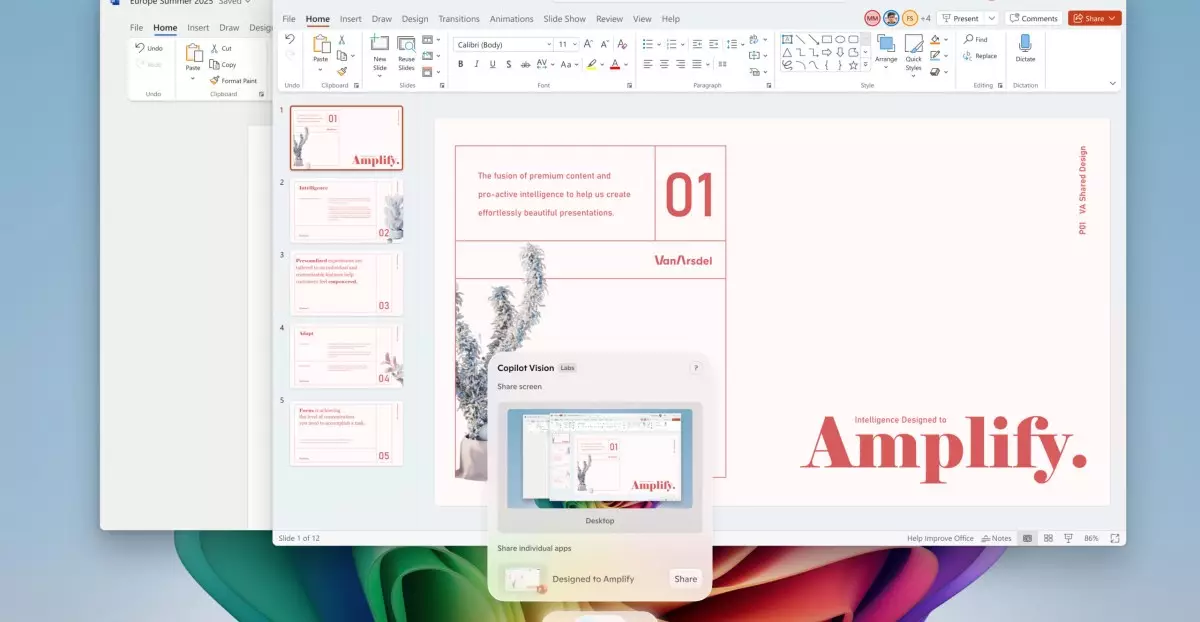In the rapidly evolving landscape of personal computing, Microsoft’s latest rollout of AI-enhanced features for Windows 11 signifies a pivotal shift towards more intuitive and proactive user experiences. At the core of this transformation is the introduction of Copilot Vision, an innovative tool that leverages artificial intelligence to analyze everything on your screen. This isn’t mere incremental upgrade; it represents a fundamental reimagining of how users interact with their devices. Instead of passive interfaces that respond only to commands, Windows 11 now offers a proactive system capable of understanding and interpreting your ongoing activities, effectively bridging the gap between human intent and machine response.
This shift is not just about implementing new functions; it’s about redefining user engagement. The ability for the AI to examine multiple open applications and web pages simultaneously, and then inform or assist based on that context, enhances productivity and minimizes frustration deep-seated in navigating complex workflows. Asking questions aloud about content displayed, or receiving suggestions for editing and organizing your media or documents, turns your PC into a collaborative assistant rather than a mere tool. Such capabilities suggest a future where the boundaries between user and computer blur, fostering a more seamless, almost organic, interaction paradigm.
Exclusive Innovations for the Power User: The Copilot Plus Advantage
While all Windows 11 users gain access to a version of Copilot Vision, a more potent, feature-rich experience awaits those with Copilot Plus-powered devices, especially Snapdragon-based PCs. These enhanced models unlock AI-driven agents embedded directly within system settings, capable of executing complex commands through natural language. Imagine simply saying, “Enable quiet hours,” and watching your PC implement the change without digging through menus. This not only simplifies operation but democratizes tech-savvy tasks, making professional-grade automation accessible to everyday users.
The ‘Click to Do’ feature exemplifies this democratization fervently. By holding the Windows key and clicking on specific content—be it text, images, or links—users can invoke tailored actions instantly. The system’s new abilities extend these capabilities further—summarizing texts, aiding in pronunciation through Reading Coach, drafting documents, or even scheduling meetings—all through straightforward, conversational prompts. With such features, Microsoft is not just enhancing productivity; it is transforming PCs into personalized, intelligent collaborators that understand context and execute tasks with minimal user input.
Furthermore, the suite of AI-powered creative and editing tools like sticker generation in Paint and advanced object selection in images signals a future where content creation becomes faster, more intuitive, and highly accessible. These features push beyond routine computing tasks, embedding AI deeply into artistic and professional workflows. For Snapdragon users, the enhancements in photo lighting and AI-driven screenshot precision underscore the strategic emphasis on mobile and high-performance devices—highlighting Microsoft’s recognition of mobility’s critical role in modern productivity.
Broadening Accessibility and Enhancing Stability
Microsoft’s commitment to integrating AI features across its ecosystem includes updates available to all Windows 11 devices, regardless of hardware capabilities. Practical tools like an improved color picker or automatic troubleshooting for unexpected system restarts underline a nuanced understanding of user needs—prioritizing stability, convenience, and usability. These non-AI features may seem minor, but they greatly impact user experience by streamlining everyday tasks and maintaining system health. They demonstrate that even amidst revolutionary AI advancements, foundational usability remains paramount.
This balanced approach indicates a strategic vision: driving innovation while ensuring broad accessibility. As these features roll out gradually over the coming weeks, they suggest Microsoft’s dedication to refining and expanding intelligent functionalities, all while maintaining a focus on practical improvements that cater to users’ everyday needs.
Yet, it’s crucial to scrutinize whether AI integrations truly enhance user autonomy or risk becoming over-reliant on automation. The temptation for tech companies to overpromise while underdelivering or to embed intrusive features cloaked as helpful tools remains. Microsoft’s cautious, phased rollout indicates awareness of these pitfalls, but the real test lies in how intuitively these features adapt to human complexity rather than expecting users to conform to the AI’s logic.
The Future Outlook: Potential and Pitfalls
Microsoft’s AI ambitions are undeniably ambitious, painting a future where Windows is less of an operating system and more of an intelligent partner. Such integrations hint at a landscape where devices anticipate needs, simplify complexities, and foster creativity and productivity like never before. However, with this innovation comes the challenge of balancing privacy concerns and the risk of over-dependence on AI-driven automation. Users must remain cautious, ensuring that they retain control and understanding over their devices, rather than surrendering autonomy to a seemingly all-knowing system.
While Microsoft’s vision is bold, the true impact of these features will depend on their execution in real-world scenarios. The promise of an intelligent Windows experience—combining proactive assistance with creative empowerment—is compelling. Yet, whether these tools will truly revolutionize user productivity or simply add superficial fluff remains to be seen. For now, Windows 11 users stand on the cusp of a paradigm shift that, if managed thoughtfully, could redefine personal and professional computing for the better.

